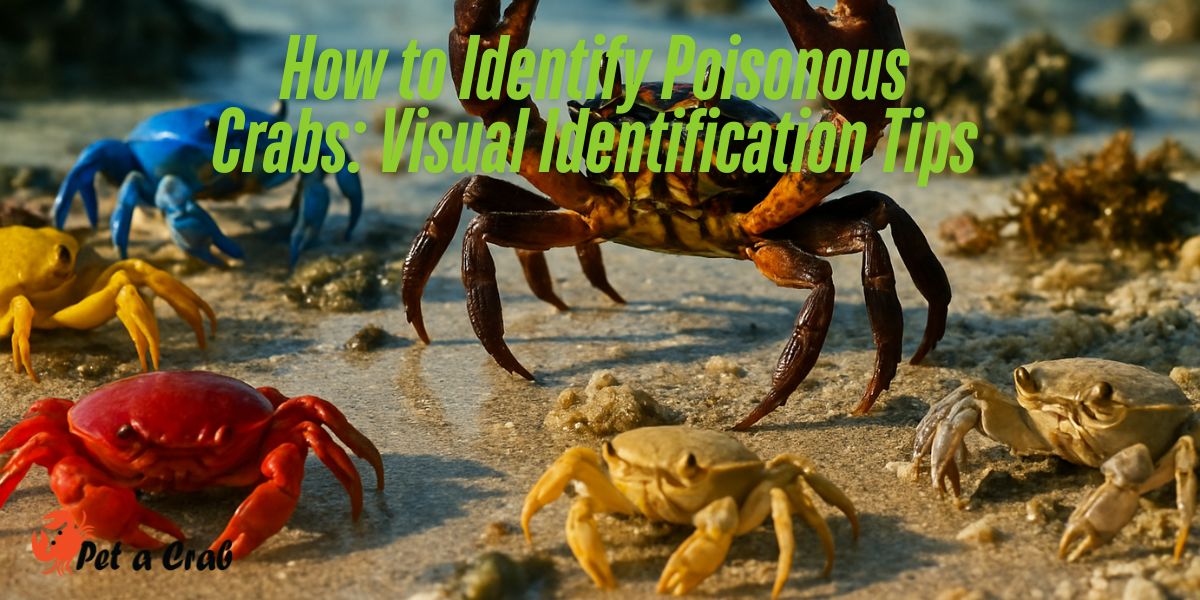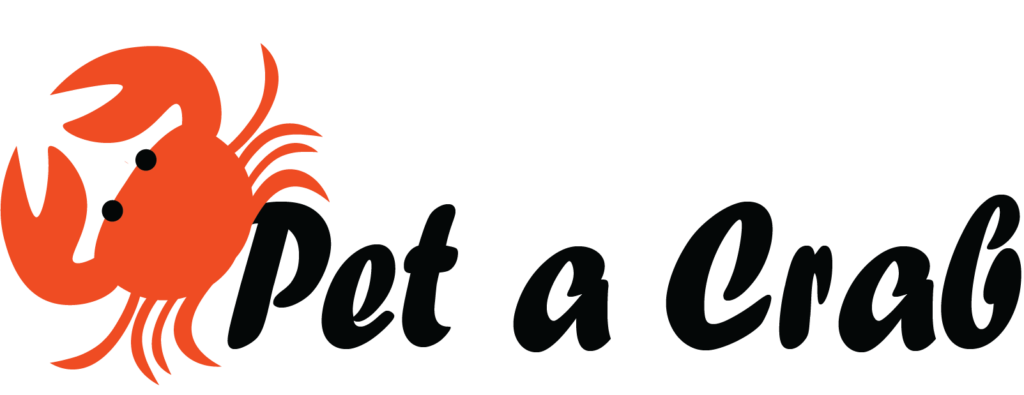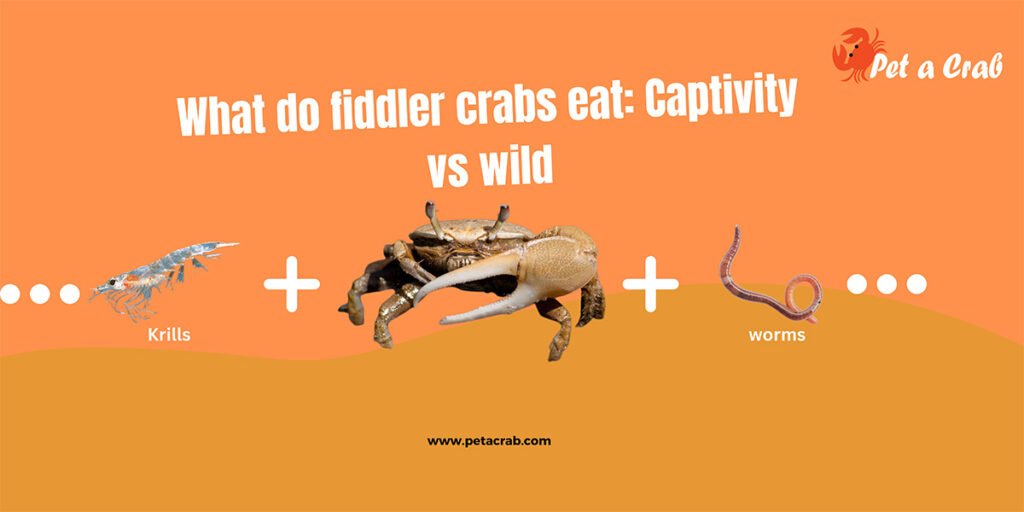Not all crabs make good pets! Some crabs contain toxins that can harm you or other pets that live in your tank. That’s why learning how to identify poisonous crabs is so important before you bring one home. This guide will answer common questions, such as “Are crabs venomous?” “What kind of crab is poisonous?” and “Do crabs have venom?” So you’ll feel confident to look after your pet.

Understanding Poisonous vs. Venomous Crabs
One of the biggest misconceptions about crabs is the difference between poisonous and venomous species. While these terms are often used interchangeably, they describe two distinct forms of toxicity.
Are There Venomous Crabs?
Venomous crabs are extremely rare. Unlike poisonous crabs, which contain toxins in their bodies, venomous crabs would need to inject something most crabs cannot do. Some species may have mild toxins, but they are not dangerous to humans.
Can Pet Crabs Be Dangerous?
Most pet crabs are safe, but some can pose risks. Certain crabs absorb harmful substances from their habitat, making them unsafe if consumed. While some species resist marine toxins, this does not mean they are harmless pets. Always research before choosing a crab as a pet.
Do Crabs Have Venom?
Crabs do not produce venom like jellyfish or sea snakes. However, some, like Xanthid crabs, carry dangerous toxins such as tetrodotoxin and saxitoxin. These toxins remain deadly even after cooking.
How to Identify Poisonous Crabs?
Crabs are fascinating pets, but some carry hidden toxins. Understanding how to identify poisonous crab species is crucial for a safe tank environment. Below, I’ll discuss how to identify toxic crabs and keep your aquarium risk-free.
Bright and Unnatural Coloration
Crabs with bright red, yellow, blue, or purple shells often signal toxicity. But not all; many marine species use vibrant colors as a warning to predators. However, if a crab exhibits intense hues, it may be best to research its species before adding it to your tank.
Unusual Patterns and Markings
Some poisonous crabs feature irregular and multicolored patterns. For example, the harlequin crab has intricate, vibrant markings that indicate it may harbor toxins. Additionally, any crab with an abnormally bright or striking pattern should be closely examined before introduction into a home aquarium.
Habitat and Geographic Origin
Poisonous crabs are more common in tropical and reef environments, where they feed on venomous prey. Crabs from Indo-Pacific regions, mangrove swamps, or coral reefs may contain toxins that accumulate through their diet.
Unusually Large Claws
Crabs with disproportionately large claws, such as the stone crab, may use them for defence and toxin injection. While not all large-clawed crabs are poisonous, their ability to crush and potentially transmit toxins through wounds should not be overlooked.
Aggressive or Defensive Behavior
Poisonous crabs often exhibit heightened defensive behaviors, raising claws aggressively or adopting intimidating postures. Some may even secrete toxins when threatened. A crab that overreacts to touch or movement might be best kept in isolation until its species is confirmed safe.
Feeding Habits and Diet
Crabs that consume toxic prey, such as certain algae, sponges, or venomous marine life, may accumulate harmful substances in their bodies. If a crab’s natural diet includes known toxic species, there’s a high chance it can transfer those toxins to its surroundings.
Common Poisonous and Venomous Crabs
When it comes to keeping crabs as pets, it’s essential to be aware of which crabs you should avoid. While many crabs are harmless, others can pose risks either through venom or by accumulating toxins from their environment. Below, I will discuss some of the common poisonous and venomous crabs that pet owners should watch out for.
Are Coconut Crabs Poisonous?
A coconut crab (Birgus latro), the largest land-dwelling arthropod, is not poisonous by nature like strawberry crab. However, their diet can cause them harm. In their diet, they can accumulate toxic compounds, including cerberin, a potent cardiac glycoside, from certain plants, notably the sea mango (Cerbera manghas). It was reported in Medicine Tropicale that coconut crabs ingesting toxic plants caused 23 cases of poisoning, with four deaths.
Is Purple Crab Poisonous?
The Purple Vampire Crab (Geosesarma sp.) is non-poisonous and can be handled safely. Although they have vibrant colors, they pose no harm to humans or pets. For them to thrive, they need appropriate care, including a land-water habitat and avoiding plants that may harm them.
Are Hermit Crabs Venomous?
The hermit crab is not venomous and can be kept as a pet without any risk of harm. It’s important to remember that they can harbor bacteria in the form of Vibrio, which if handled improperly can cause infections. In order to avoid infection, the CDC recommends thorough handwashing after handling hermit crabs.
Are Crab Spiders Venomous To Humans?
There may be some confusion about these crab spiders because of their name, but they are not actually crabs. While crab spiders are venomous to their prey, they pose little risk to humans. In most cases, bites result in mild symptoms like redness or swelling that subside quickly.
Are Flower Crab Spiders Poisonous?
Flower crab spiders are venomous but not dangerous to humans. Their venom is not strong enough to cause harm to people but helps them subdue insect prey. Though an allergic reaction to a bite is possible.
Are Goldenrod Crab Spiders Venomous?
Like flower crab spiders, they possess venom, but it is not harmful to humans. They use this venom to capture and immobilize their prey, typically small insects. The Journal of Arachnology explains that while their venom can be potent to their prey, it has no significant effects on humans.
Are Spider Crabs Venomous?
The spider crab is not poisonous in spite of its name. Humans are not at risk from these crabs known for their long, spindly legs. As a defense mechanism, spider crabs rely on camouflage rather than venom to avoid predators.
Are Green Crab Spiders Venomous?
There is also a venomous type of crab spider known as green crab spider. However, their venom is not dangerous to humans. Their venom immobilizes their insect prey. Unlike other crab spiders, green crab spiders bite only if threatened, but their venom is harmless to humans.
Are Mosaic Crabs Poisonous?
The Mosaic Crab (Lophozozymus pictor) is one of the most poisonous crabs in the world. Found in tropical waters, its toxins remain lethal even after cooking, making it extremely dangerous for consumption.
Are Horseshoe Crabs Venomous?
The horseshoe crab is not venomous. In addition to being harmless to humans, they are also harmless to other marine animals. Due to their unique blue blood, they play a crucial role in marine ecosystems and medical research despite their intimidating appearance.
What to Do If You Have a Potentially Poisonous Crab as a Pet
While discovering that your pet crab might be poisonous can be concerning, handling the situation responsibly ensures both your and other inhabitants’ safety. Make sure you follow these steps when handling a crab that could be toxic, like as gaudy clown crab and the teddy bear crab.
Identify the Species Accurately
You should research the species, the toxicity, and the habitat of your crab. To identify marine species accurately, consult credible sources or online aquarist communities.
Minimize Direct Contact
To avoid allergic reactions or toxins, wear gloves when handling crabs. You should wash your hands after being bitten and watch out for any symptoms such as numbness or swelling.
Isolate the Crab from Tank Mates
To protect your other aquatic life, move your crab into a separate tank if it behaves aggressively or releases toxins.
Monitor Behavior and Environmental Impact
Monitoring crab activity and water quality regularly to detect harmful toxins are important. By releasing waste or secretions, toxic species can disrupt the ecosystem of the tank.
Consider Rehoming or Transferring to a Specialized Facility
In cases where keeping the crab is risky, contact marine research centers, aquariums, or expert hobbyists for ethical rehoming. You should never release it into nature.
Educate Yourself and Others
Understand the risks associated with species-specific care, handling, and handling. You can help prevent similar issues by sharing your knowledge with fellow hobbyists.
Frequently Asked Questions
How do you tell if a crab is edible or safe as a pet?
Edible crabs generally have firm, clean shells and are caught in safe, non-polluted waters. Ensure crabs kept as pets, like the fiddler crab, are from reputable sources.
What is the most venomous crab?
The box crab is one of the most venomous species. While they’re rare in the pet trade, it’s good to be aware of the species you’re keeping.
Which bit of crab is poisonous?
The abdomen and internal organs of certain crabs, like the stone crab, are where toxins are often found. Always remove the organs if you’re harvesting crabs for food.
Are crab spiders poisonous to humans?
Most crab spiders aren’t harmful to humans, but their bite can cause minor irritation. If you’re concerned, ensure no spiders are kept in your crab’s tank.
Do all bright-colored crabs have venom?
There are some colorful crabs that are not venomous. The bright colors of many species often serve as a warning to predators, but fiddler crabs, for example, are perfectly safe for pets.
Are flower crab spiders venomous?
In spite of the fact that flower crab spiders are venomous, humans pose little threat from them. To avoid potential conflict, keep such spiders away from your crabs.
Resources:
- https://www.cdc.gov/vibrio/about/index.html
- Maillaud C, Barguil Y, Cheze M, Mikulski M, Le Coq St Gilles H, Lapostolle F, Hnawia E, Lebouvier N, Pivert C, Deveaux M, Nour M. Caractérisation des intoxications par le crabe de cocotier Birgus latro L. en Nouvelle-Calédonie : données cliniques, toxinologiques et thérapeutiques, à partir de vingt-trois cas [Characterization of poisoning by the coconut crab, Birgus latro, in New Caledonia: aspects of clinical and toxicological features and treatment in 23 cases]. Med Sante Trop. 2015 Jul-Sep;25(3):285-90. French. doi: 10.1684/mst.2015.0486. PMID: 26446742.
- TY – JOUR
AU – Maillaud, Claude
AU – Lefebvre, S.
AU – Sebat, Catherine
AU – Barguil, Yann
AU – Cabalion, Pierre
AU – Chèze, Marjorie
AU – Hnawia, Edouard
AU – Nour, Mohammed
AU – Durand, F.
PY – 2010/01/31
SP – 81
EP – 86
T1 – Double lethal Coconut Crab (Birgus latro L.) poisoning
VL – 55
DO – 10.1016/j.toxicon.2009.06.034
JO – Toxicon


